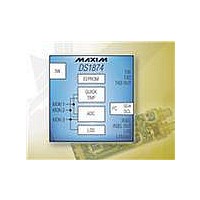DS1874T+ Maxim Integrated Products, DS1874T+ Datasheet - Page 22

DS1874T+
Manufacturer Part Number
DS1874T+
Description
IC CTLR SFP+ ANLG LDD 28-TQFN
Manufacturer
Maxim Integrated Products
Type
Laser Diode Controllerr
Datasheet
1.DS1874TTR.pdf
(88 pages)
Specifications of DS1874T+
Number Of Channels
1
Voltage - Supply
2.85 V ~ 3.9 V
Current - Supply
2.5mA
Operating Temperature
-40°C ~ 95°C
Package / Case
28-WFQFN Exposed Pad
Mounting Type
Surface Mount
Number Of Outputs
5
Duty Cycle (max)
50 %
Output Voltage
0 V to 3.9 V
Mounting Style
SMD/SMT
Switching Frequency
0 KHz to 400 KHz
Operating Supply Voltage
2.85 V to 3.9 V
Supply Current
2.5 mA to 10 mA
Maximum Operating Temperature
+ 95 C
Fall Time
300 ns
Minimum Operating Temperature
- 40 C
Rise Time
300 ns
Synchronous Pin
Yes
Lead Free Status / RoHS Status
Lead free / RoHS Compliant
Other names
90-1874T+000
same signals and faults can also be used to generate
the internal signal FETG (Table 01h/05h, Registers FAh
and FBh). FETG is used to send a fast “turn-off” com-
mand to the laser driver. The intended use is a direct
connection to the MAX3798/MAX3799’s TXD input if
this is desired. When V
impedance.
SFP+ Controller with Digital LDD Interface
Figure 13. Logic Diagram 2
Figure 14a. TXF Nonlatched Operation
Figure 14b. TXF Latched Operation
22
LOS LO
______________________________________________________________________________________
RSEL
LOS
IN1
DETECTION OF TXF FAULT
DETECTION OF TXF FAULT
RSELC
LOSC
MUX
IN1S
IN1C
RSELS
INV LOS
TXD
INVOUT1
TXF
TXF
CC
RXL
< POA, TXDOUT is high
OUT1
RSELOUT
LOSOUT
TXF can be triggered by all alarms, warnings, and
quick trips (Figure 12). The six ADC alarms, warnings,
and the LOS quick trips require enabling (Table
01h/05h, Registers F8h and FDh). See Figures 14a and
14b for nonlatched and latched operation. Latching of
the alarms is controlled by the CNFGB and CNFGC
registers (Table 02h, Registers 8Ah–8Bh).
The DS1874 has an ID hardcoded in its die. Two regis-
ters (Table 02h, Registers CEh–CFh) are assigned for
this feature. The CEh register reads 74h to identify the
part as the DS1874, while the CFh register reads the
current device version.
The DS1874 controls the MAX3798/MAX3799 over a
proprietary 3-wire interface. The DS1874 acts as the
master, initiating communication with and generating
the clock for the MAX3798/MAX3799. It is a 3-pin inter-
face consisting of SDAOUT (a bidirectional data line),
an SCLOUT clock signal, and a CSELOUT chip-select
output (active high).
The DS1874 initiates a data transfer by asserting the
CSELOUT pin. It then starts to generate a clock signal
3-Wire Master for Controlling
the MAX3798/MAX3799
Transmit Fault (TXF) Output
Die Identification
Protocol











